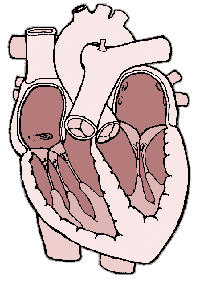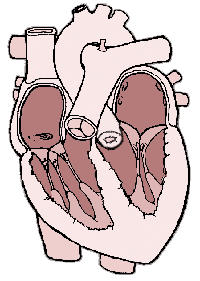
© Copyright Goldendoodles.com 2001. All rights reserved. You may not copy or otherwise use anything on this site without our written permission.


S.A.S. refers to Subvalvular Aortic Stenosis, one of the more common heart malformations in
dogs. In a mild form, there are a few nodes just under the aorta, barely affecting the flow of
blood, and the quality of life for the dog remains optimistic. In a severe form there is a fibrous
wreath surrounding the vessel partially blocking the flow of blood. This causes undo stress on
the heart pushing the blood through a narrower opening, and on the constricted blood vessel
itself. Dogs will experience chronic fatigue and at it's most extreme, sudden death.
It is genetically inherited although it's difficult to test for. There are no blood or DNA tests to
easily identify it. Carriers are discovered as they grow and begin to manifest symptoms. Unlike
most genetic problems, it is at times undetectable by any known means until the pup is several
weeks old.
In genetic terms the mode of inheritance is complex and much is still not understood. In
Newfoundland dogs it is being studied as an autosomal dominant trait with variable expressivity
or as a polygenic trait. It means that only one parent has to have it, and all of their offspring have
a possibility of being affected to various degrees. A recent study using Golden Retrievers and
Newfoundlands, has suggested that it is inherited as a dominant gene with incomplete
penetrance and variable expression. This means that a percentage of the pups will be affected to
various degrees.
One of the first ways to detect a problem is to have a Vet screen the heart, listening for a heart
murmur, associated to heart problems. If there is no murmur detected by 6-8 weeks old, the pup
is considered free of heart problems. If a murmur is present, then the pup should be examined
more extensively. Pups with moderate to severe S.A.S. can be diagnosed as young as 6-8 weeks.
Depending on the severity, the overt symptoms will be exercise intolerance, fainting, heart failure
or sudden death. S.A.S. is a progressive disease. The heart has to work harder and it's muscle,
the wall of the heart, gets thicker over time which causes more problems with it's ability to beat
regularly and to pump blood. It will cause them to become fatigued easily and perhaps faint.
When the heart muscle is very thick the heart rhythm becomes very irregular, cardiac arrhythmia,
and the heart can stop.
A pup can have an `innocent heart murmur', which means the pup will have a mild murmur until
about 12-14 weeks old and then it will disappear. Afterwards, they also can be considered clear
of heart problems and fit to breed, unless there is a family history of S.A.S. If the murmur
continues beyond 14 weeks it is advised that more extensive testing is done - echocardiography
or cardiac catheterization and angiocardiography. Murmurs can occur without any heart ailment,
although it is advised that these dogs not be used as breeding dogs. As well, there is a small
percentage of S.A.S. carriers who go undetected as they have no murmur.
The Orthopedic Foundation for Animals (OFA), will register and catagorize dogs as;
1) Normal - congenital heart disease not evident,
2) Equivocal - congenital heart disease cannot be diagnosed nor excluded
3) Abnormal - examination indicative of congenital heart disease.
One difficulty in diagnosing SAS is that the heart murmur heard with SAS and the heart murmur
heard in athletic and excited dogs (physiologic murmurs) are very similar. A dog with a
predisposition to be athletic, will have an increased heart rate when not in good physical
condition. So dogs with these athletic murmurs can actually be better performers and more
desireable as breeding dogs. The examiner must have a great deal of expertise in order to
discern the difference between these two types of murmurs.
Blue Sterling, B.A.,
Goldendoodles.com
©Copyright Goldendoodles.com 2001
All rights reserved.
You may not copy or otherwise use anything on this site without our written permission.
References
• Aortic Stenosis
by Dr. Cathy Priddle
http://www.rottclub.ca/aortic.html
• Hips, Elbows, Eyes and Hearts: Update on the Big Four
Golden Retriever Club of America
By Ann F. Hubbs DVM, PhD
http://www.grca.org/health/bigfour.html
• Inheritance and Molecular Genetic Evaluation in Newfoundlands and Golden Retrievers with
Subvalvular Aortic Stenosis
American Kennel Club, Canine Health Foundation
By Lehmkuhl, L..B., and K.M. Meurs. Completed Grant No. 1419
http://www.akcchf.org/research/grants/search/index.cfm?search=disease&display=results&diseas
e=Heart%20Disease
• SAS - What it is, and Why Breeder Should be Concerned
by Denise Mankin, DVM, 1996
http://www.europa.com/~dshecklr/SAS.html
• Sub-aortic Stenosis (SAS) - A Heart Breaking Problem
Best Beau BMD Health Info Links,
Sub-aortic Stenosis
http://www.bestbeau.ca/SAS.htm
• Sub-Aortic Stenosis - 'SAS'...a heart condition
Rottweiler Health Foundation
Health Issues, Heart, Sub-aortic Stenosis - `SAS'
RottweilerHealth.org
http://www.rottweilerhealth.org/rott_healthissues.html#CANINE
• Subaortic Stenosis
University of Pennsylvania Veterinary Medicine,
Department of Clinical Studies, Cardiology
http://www.vet.upenn.edu/departments/csp/cardiology/brochures/Subaortic%20stenosis.pdf
• Type A aortic stenosis, Type B aortic stenosis, subvalvular aortic stenosis
University of Prince Edward Island, Canada
Atlantic Veterinary College at UPEI, Canada
Animal Welfare Unit
Canadian Veterinary Medical Association.
http://www.upei.ca/cidd/Diseases/cardiovascular%20diseases/aorticstenosis.htm
* illustration courtesy of Mostly Medical Clipart
Subvalvular Aortic Stenosis (S.A.S.)
The information contained on this site is in no way intended to replace that of proper veterinary advice, diagnosis or treatment.
It is meant to provide resource, so that we can better understand canine health related issues.


NORMAL HUMAN HEART
AORTIC STENOSIS
narrowing below valve,
thickening of heart muscle

© Copyright Goldendoodles.com 2001. All rights reserved. You may not
copy or otherwise use anything on this site without our written permission
Made with Xara

The information contained on this site is in no way intended to
replace that of proper veterinary advice, diagnosis or treatment.
It is meant to provide resource, so that we can better understand
canine health related issues.
Subvalvular Aortic Stenosis (S.A.S.)


NORMAL HUMAN HEART
AORTIC STENOSIS
narrowing below valve,
thickening of heart muscle
S.A.S. refers to Subvalvular Aortic Stenosis, one of the more
common heart malformations in dogs. In a mild form, there are a
few nodes just under the aorta, barely affecting the flow of blood,
and the quality of life for the dog remains optimistic. In a severe
form there is a fibrous wreath surrounding the vessel partially
blocking the flow of blood. This causes undo stress on the heart
pushing the blood through a narrower opening, and on the
constricted blood vessel itself. Dogs will experience chronic fatigue
and at it's most extreme, sudden death.
It is genetically inherited although it's difficult to test for. There are
no blood or DNA tests to easily identify it. Carriers are discovered as
they grow and begin to manifest symptoms. Unlike most genetic
problems, it is at times undetectable by any known means until the
pup is several weeks old.
In genetic terms the mode of inheritance is complex and much is still
not understood. In Newfoundland dogs it is being studied as an
autosomal dominant trait with variable expressivity or as a polygenic
trait. It means that only one parent has to have it, and all of their
offspring have a possibility of being affected to various degrees. A
recent study using Golden Retrievers and Newfoundlands, has
suggested that it is inherited as a dominant gene with incomplete
penetrance and variable expression. This means that a percentage
of the pups will be affected to various degrees.
One of the first ways to detect a problem is to have a Vet screen the
heart, listening for a heart murmur, associated to heart problems. If
there is no murmur detected by 6-8 weeks old, the pup is considered
free of heart problems. If a murmur is present, then the pup should
be examined more extensively. Pups with moderate to severe S.A.S.
can be diagnosed as young as 6-8 weeks. Depending on the severity,
the overt symptoms will be exercise intolerance, fainting, heart
failure or sudden death. S.A.S. is a progressive disease. The heart
has to work harder and it's muscle, the wall of the heart, gets thicker
over time which causes more problems with it's ability to beat
regularly and to pump blood. It will cause them to become fatigued
easily and perhaps faint. When the heart muscle is very thick the
heart rhythm becomes very irregular, cardiac arrhythmia, and the
heart can stop.
A pup can have an `innocent heart murmur', which means the pup
will have a mild murmur until about 12-14 weeks old and then it will
disappear. Afterwards, they also can be considered clear of heart
problems and fit to breed, unless there is a family history of S.A.S. If
the murmur continues beyond 14 weeks it is advised that more
extensive testing is done - echocardiography or cardiac
catheterization and angiocardiography. Murmurs can occur without
any heart ailment, although it is advised that these dogs not be used
as breeding dogs. As well, there is a small percentage of S.A.S.
carriers who go undetected as they have no murmur.
The Orthopedic Foundation for Animals (OFA), will register and
catagorize dogs as;
1) Normal - congenital heart disease not evident,
2) Equivocal - congenital heart disease cannot be diagnosed nor
excluded
3) Abnormal - examination indicative of congenital heart disease.
One difficulty in diagnosing SAS is that the heart murmur heard with
SAS and the heart murmur heard in athletic and excited dogs
(physiologic murmurs) are very similar. A dog with a predisposition
to be athletic, will have an increased heart rate when not in good
physical condition. So dogs with these athletic murmurs can actually
be better performers and more desireable as breeding dogs. The
examiner must have a great deal of expertise in order to discern the
difference between these two types of murmurs.
Blue Sterling, B.A.,
Goldendoodles.com
©Copyright Goldendoodles.com 2001
All rights reserved.
You may not copy or otherwise use anything on this site without our
written permission.
References
• Aortic Stenosis
by Dr. Cathy Priddle
http://www.rottclub.ca/aortic.html
• Hips, Elbows, Eyes and Hearts: Update on the Big Four
Golden Retriever Club of America
By Ann F. Hubbs DVM, PhD
http://www.grca.org/health/bigfour.html
• Inheritance and Molecular Genetic Evaluation in Newfoundlands
and Golden Retrievers with Subvalvular Aortic Stenosis
American Kennel Club, Canine Health Foundation
By Lehmkuhl, L..B., and K.M. Meurs. Completed Grant No. 1419
http://www.akcchf.org/research/grants/search/index.cfm?search=dis
ease&display=results&disease=Heart%20Disease
• SAS - What it is, and Why Breeder Should be Concerned
by Denise Mankin, DVM, 1996
http://www.europa.com/~dshecklr/SAS.html
• Sub-aortic Stenosis (SAS) - A Heart Breaking Problem
Best Beau BMD Health Info Links,
Sub-aortic Stenosis
http://www.bestbeau.ca/SAS.htm
• Sub-Aortic Stenosis - 'SAS'...a heart condition
Rottweiler Health Foundation
Health Issues, Heart, Sub-aortic Stenosis - `SAS'
RottweilerHealth.org
http://www.rottweilerhealth.org/rott_healthissues.html#CANINE
• Subaortic Stenosis
University of Pennsylvania Veterinary Medicine,
Department of Clinical Studies, Cardiology
http://www.vet.upenn.edu/departments/csp/cardiology/brochures/S
ubaortic%20stenosis.pdf
• Type A aortic stenosis, Type B aortic stenosis, subvalvular aortic
stenosis
University of Prince Edward Island, Canada
Atlantic Veterinary College at UPEI, Canada
Animal Welfare Unit
Canadian Veterinary Medical Association.
http://www.upei.ca/cidd/Diseases/cardiovascular%20diseases/aortics
tenosis.htm
* illustration courtesy of Mostly Medical Clipart



